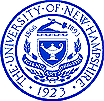
Interactive Data Explorer
Gulf of Maine Nutrient Information System
Welcome Page


|
Interactive Data Explorer
|

|
Great Bay Project Summary and Rationale
Excess nutrient loading to coastal basins can cause a wide array of harmful environmental problems. This coastal loading is a direct result of anthropogenic activities and development occurring in upstream basins. However, exactly how humans impact our coastal zones is not yet completely understood. The goal of this project is to explore and understand these controls on The Great Bay estuary by examining relationships between river nutrients, landuse, and discharge at seven of the major rivers draining into this New England estuary. Water samples, collected twice a month are analyzed colorimetrically for the nutrients nitrate (NO3), nitrite (NO2), ammonium (NH4), phosphate (PO4), and silicate (SiO4). These concentrations are coupled with estimated daily discharge values at the sampling location to calculate flux values. Nutrient concentration, flux, discharge, sampling date, season, and landuse statistics are used to perform multiple component analyses of the data. Results of these analyses indicate that, while there is a significant difference between mean flux values in the different basins, the variation does not appear to be related to landuse. Rather, those rivers with elevated mean flux values may be able to attribute this increase in nutrients to the presence of Waste Water Treatment Facilities discharging upstream
|
|